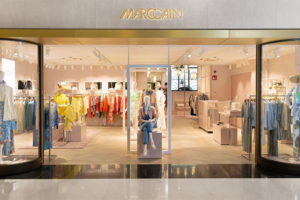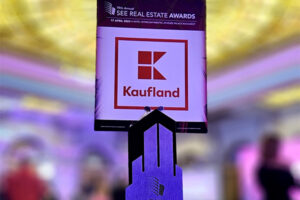BY JONATHAN DOUGHTY
There are many indicators to point to the increased comfort that our customers, our “guests”, are feeling, but the most obvious and easy one to measure is their spend on foodservice in shopping centers. Typically this data has been measured for a long time, so trends can be spotted, but only on the big numbers – until now.
The title of my article this month is “A Lesson in Foodservice Economics,” which came to me as I was speaking at the German Council of Shopping Centers Congress in Berlin in September. The event was incredibly well organized, massively well attended, and the combined knowledge, experience, and understanding of the German shopping center market and beyond was inspiring. As ever with our developer and landlord clients, there is always a need to find the “magic bullet,” the one thing that fixes all the problems in one go and in horeca (foodservice), the “big” problem is the lack of operators who want to open and operate in the German market. I disagree, however. The BIGGER problem is that shopping centers in Germany are only now beginning to build the sort of differentiated real estate for food that makes it a “destination.” CentrO Oberhausen was ahead of its time in many ways, but the vast majority of shopping centers provide “shopping center” food solutions. Low spend, quick service, low experience food courts. In addition, these are harder to build, run, and get tenants for, and generally provide a lower return.
Opportunities for “something better”
So it is not a good picture. Or is it? Most of our clients in Germany tell us that the guests want cheap food. Most of our research suggests that some guests want cheap food, but they are not the ones that will necessarily shop in the center, and the more you move up the spend graph, the less opportunity there is for those guests who want “something better.” It is entirely true to say that the German shopping center industry has taught the customers that they SHOULD NOT try to find great foodservice in a shopping center! But this is now changing.
In the same way that shopping centers are no longer just about shops, in the same way that the economy has moved from a “consumption-based” economy to an “experience-based” economy, foodservice and horeca is changing as well. In Germany, it has taken a little longer, but please be ready for a very quick acceleration in this area soon.
10 years ago, most German shopping center visitors in most towns and cities would not have dreamed of going to a mall to eat as an “experience.” They shopped and ate food as a functional, basic requirement and, because it was basic, they paid a basic amount: three to four euros. It was still one meal, but it was very cheap. Now think ahead to today, when that same guest and his family, a nice group of mum, dad, son, and daughter, find in the latest and greatest shopping center a garden square, surrounded by four or five really nice restaurants, offering pizza, Asian, sushi, steak, and Hispanic fare. They choose one restaurant for the meal and this time they spend 15 euros each. One meal occasion, five times the spend. Sure, they won’t do that all the time, but if we don’t offer “better” then don’t expect our guests to buy “better.” The environment was not a mall with a converted shop as a restaurant. It was purpose-built.
Broadening the mix
The second lesson is about broadening the mix so that there are a variety of price points, buying occasions, and dwell times. If all you offer is a food court, all you will attract are food court customers. If 10% of your footfall is more affluent, more demanding, and more “experience driven,” however, that 10% can account for the same spend as 35% of the food court customers. Think shoes: If all you have is a “bargain discount” shoe store, those guests who want better won’t spend, as they won’t sell Kurt Geiger or Jimmy Choo, or even something moderately expensive. It is the same with food.
The third lesson is more about time than it is about money, but time is becoming the most precious thing for most German consumers and others throughout Europe. Work, travel, commercial, and economic pressures have all taken time away from us and so when we do go out, when we do want foodservice, time plays an important part. I often want something nice and healthy for lunch, often hot, but I really don’t have 35 to 45 minutes. “Food court” food doesn’t really do it for me, so I look for, and often find, the new types of “fast casual” operators who will give me a great product very quickly – and I don’t mind paying more for it. Time is MONEY.
Across Europe, the spend per footfall (customers to your center) ranges from €1.10 to €1.50. So a mall that attracts 10 million people typically has a foodservice turnover of 15 million euros. This reflects, in my view, the nature of the offer being provided to them. If it were broader, there would be a higher per head. Not everybody will spend a lot more, but some will. I anticipate that, within three to five years’ time, if the product and range of offers is MUCH better, this spend will rise to three euros per head – double where it is today. In the face of declining footfalls, this is a seriously important step forward, with strong growth potential and, more importantly, a reason why foodservice operators WILL WANT to be in shopping centers.
Please ask yourself one question when you are next thinking about building some new foodservice: “Is this good enough to compete with the best we have locally and regionally?”
Sometimes I dream, and when I dream I see a future for malls where they are “experience centers,” where you can get great service, amazing foodservice and social spaces, great “art and performance,” lovely “places for people” to enjoy, and, IF YOU ARE REALLY LUCKY, they will spend some money in the shops. Dream on.





![Titel_Across_1_24_Endversion[111270] Titel_Across_1_24_Endversion[111270]](https://www.across-magazine.com/wp-content/uploads/elementor/thumbs/Titel_Across_1_24_Endversion111270-qjpg2yp7x6msxzo90wpo62uop32tmjtjils84ezryg.jpg)
